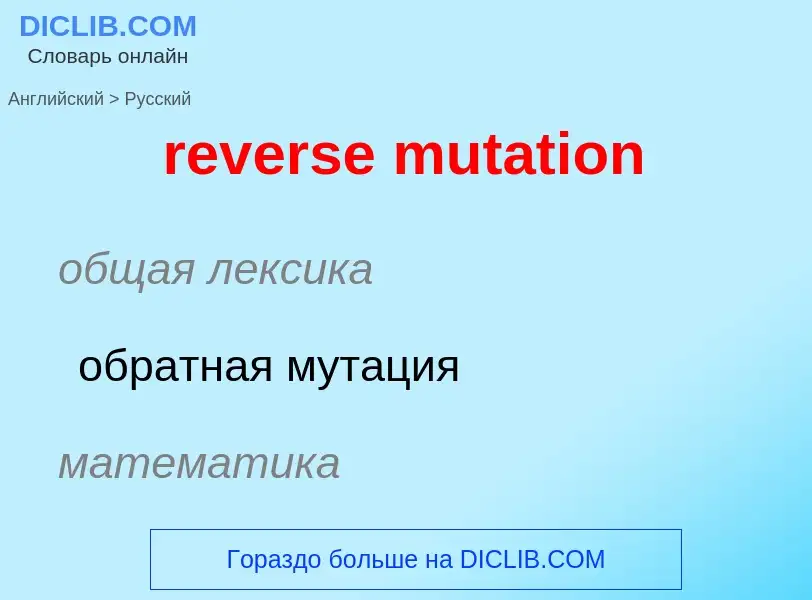Перевод и анализ слов искусственным интеллектом ChatGPT
На этой странице Вы можете получить подробный анализ слова или словосочетания, произведенный с помощью лучшей на сегодняшний день технологии искусственного интеллекта:
- как употребляется слово
- частота употребления
- используется оно чаще в устной или письменной речи
- варианты перевода слова
- примеры употребления (несколько фраз с переводом)
- этимология
reverse mutation - перевод на русский
общая лексика
обратная мутация
математика
обратимая (двунаправленная) мутация
Википедия
In biology, a mutation is an alteration in the nucleic acid sequence of the genome of an organism, virus, or extrachromosomal DNA. Viral genomes contain either DNA or RNA. Mutations result from errors during DNA or viral replication, mitosis, or meiosis or other types of damage to DNA (such as pyrimidine dimers caused by exposure to ultraviolet radiation), which then may undergo error-prone repair (especially microhomology-mediated end joining), cause an error during other forms of repair, or cause an error during replication (translesion synthesis). Mutations may also result from insertion or deletion of segments of DNA due to mobile genetic elements.
Mutations may or may not produce detectable changes in the observable characteristics (phenotype) of an organism. Mutations play a part in both normal and abnormal biological processes including: evolution, cancer, and the development of the immune system, including junctional diversity. Mutation is the ultimate source of all genetic variation, providing the raw material on which evolutionary forces such as natural selection can act.
Mutation can result in many different types of change in sequences. Mutations in genes can have no effect, alter the product of a gene, or prevent the gene from functioning properly or completely. Mutations can also occur in non-genic regions. A 2007 study on genetic variations between different species of Drosophila suggested that, if a mutation changes a protein produced by a gene, the result is likely to be harmful, with an estimated 70% of amino acid polymorphisms that have damaging effects, and the remainder being either neutral or marginally beneficial. Due to the damaging effects that mutations can have on genes, organisms have mechanisms such as DNA repair to prevent or correct mutations by reverting the mutated sequence back to its original state.


![fitness]] of each mutant was compared with the ancestral type. A fitness of zero, less than one, one, more than one, respectively, indicates that mutations are lethal, deleterious, neutral, and advantageous.<ref name="Sanjuán04" /> fitness]] of each mutant was compared with the ancestral type. A fitness of zero, less than one, one, more than one, respectively, indicates that mutations are lethal, deleterious, neutral, and advantageous.<ref name="Sanjuán04" />](https://commons.wikimedia.org/wiki/Special:FilePath/DFE in VSV.png?width=200)
![A red [[tulip]] exhibiting a partially yellow petal due to a mutation in its genes A red [[tulip]] exhibiting a partially yellow petal due to a mutation in its genes](https://commons.wikimedia.org/wiki/Special:FilePath/Darwin Hybrid Tulip Mutation 2014-05-01.jpg?width=200)


![somatic]] mutation that may also be passed on in the [[germline]]. somatic]] mutation that may also be passed on in the [[germline]].](https://commons.wikimedia.org/wiki/Special:FilePath/Portulaca grandiflora mutant1.jpg?width=200)
![''[[Prodryas persephone]]'', a Late [[Eocene]] butterfly ''[[Prodryas persephone]]'', a Late [[Eocene]] butterfly](https://commons.wikimedia.org/wiki/Special:FilePath/Prodryas.png?width=200)
![Mutation with double bloom in the Langheck Nature Reserve near [[Nittel]], Germany Mutation with double bloom in the Langheck Nature Reserve near [[Nittel]], Germany](https://commons.wikimedia.org/wiki/Special:FilePath/RagwurzDoppelblueteH1b.jpg?width=200)
